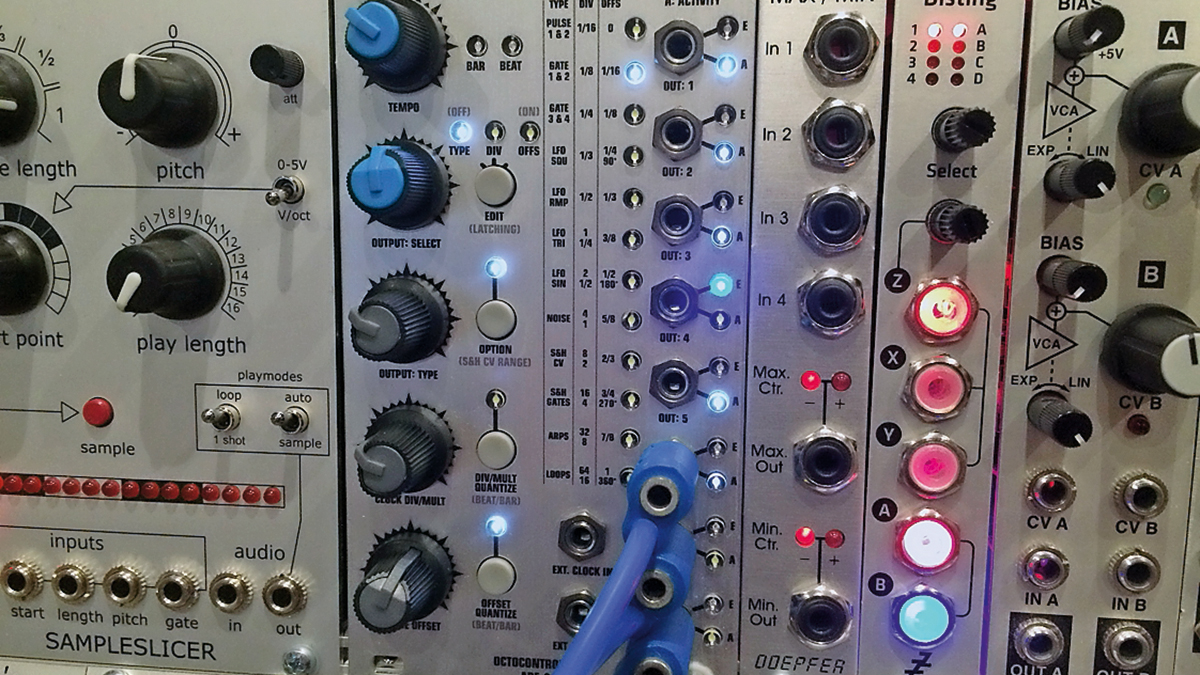How to create drum patterns and enhance synth voices with Abstract Data's Octocontroller
It might well be the module that transforms your set-up
The Octocontroller is an absolute mammoth of control, modulation and utilities. It has eight outputs that can be made to output up to 12 different types of signals, from LFOs to arpeggiated patterns, to gates and more.
We asked Justin Owen from Abstract Data how the design came about and he explained: "When I first got into modular synths, one of the things I noticed very quickly was that getting multiple modulation sources to sync was quite difficult."
Speaking from experience, that isn't just difficult, it's a real inspiration killer! The Octocontroller aims to be an antidote to this, creating gates, pulses, LFOs, S&H CV, S&H gates, rhythm loops, arpeggios and noise (the digital noise feels like a nice bonus as it can be used as an audio source), and importantly, it's all in musical sync.
Imagine building that much control with individual modules - you'd be shelling out for a master clock source, a clock divider and clock multiplier, several LFOs with tempo sync and reset capability, a noise module, S&H modules, comparators, a random looping module and arpeggiator module! There's a high possibility we wouldn't be using all those modules at the same time, but they'd take up a load of space in our system, and we'd need to get them all locked in sync somehow.
Justin set out to design a module "with a whole stack of timing and modulation sources, all running under one clock with options for offset, division and multiplication of timing". Well, we feel he's done exactly that. Output selection couldn't be simpler - a knob selects outputs 1 through 8, with a blue LED indicating which channel you're currently editing. You also get a white LED indicating that output signal, which blinks or fades to illustrate with the signal output, handy for seeing what's going on in a busy patch. Another knob sets the clock division or multiplication of your channel, and a final knob changes the outputs phase. Each output type has an additional option button: with arpeggios this cycles through ten available patterns; with LFOs it inverts their shape; and with gates or triggers it changes their lengths.
We're going to enhance a synth voice with the Octocontroller's versatile modulation capabilities and create an accompanying beat. We'll need an oscillator, envelope, VCA, filter and drum modules to be modulated by our Octocontroller, which provides our pitch CV, gates and modulation. We'll then create some random modulation to spice up the patch.
With any sort of random modulation or pattern generation we like recording everything into a DAW to capture those 'magic moments' that can often pass by quickly. Luckily with the Octocontroller's random modes we don't necessarily have to, as it continually writes its previous bar of values to internal memory. If we press the related option button, it loops the last bar into a nice repeating pattern.
Get the MusicRadar Newsletter
Want all the hottest music and gear news, reviews, deals, features and more, direct to your inbox? Sign up here.

Step 1. Create a melody with the arpeggio function. Using an oscillator's 1V/Oct input we can use the arpeggio output type to create a melodic sequence. We then run the oscillator's output into a VCA controlled by an envelope generator to modulate the signal's amplitude.

Step 2. Let's animate our pattern. The filter's cutoff is currently under the control of an LFO, but let's change that. Turn that output into a S&H CV, and we'll suddenly liven up our sequence with randomness. Pressing option loops that pattern, creating a repeating pattern.

Step 3. The Octocontroller's pulse output set to quarter notes creates a four to the floor kick pattern for a solid rhythmic foundation with a drum module. Using another quarter note pattern we can offset the phase, creating an off-beat hi-hat playing between the kicks.

Step 4. Let's add some syncopation to our beat. Using the S&H gates we can add a random gate pattern to trigger our drum sounds. But when we press the option button our random pattern will suddenly start repeating. Now it's sounding less random and more rhythmic.
Future Music is the number one magazine for today's producers. Packed with technique and technology we'll help you make great new music. All-access artist interviews, in-depth gear reviews, essential production tutorials and much more. Every marvellous monthly edition features reliable reviews of the latest and greatest hardware and software technology and techniques, unparalleled advice, in-depth interviews, sensational free samples and so much more to improve the experience and outcome of your music-making.
"If I wasn't recording albums every month, multiple albums, and I wasn't playing on everyone's songs, I wouldn't need any of this”: Travis Barker reveals his production tricks and gear in a new studio tour
“My management and agent have always tried to cover my back on the road”: Neil Young just axed premium gig tickets following advice from The Cure’s Robert Smith










